The AMD Radeon R9 Fury Review, Feat. Sapphire & ASUS
by Ryan Smith on July 10, 2015 9:00 AM ESTCompute
Shifting gears, we have our look at compute performance. As compute performance will be more significantly impacted by the reduction in CUs than most other tests, we’re expecting the performance hit for the R9 Fury relative to the R9 Fury X to be more significant here than under our gaming tests.
Starting us off for our look at compute is LuxMark3.0, the latest version of the official benchmark of LuxRender 2.0. LuxRender’s GPU-accelerated rendering mode is an OpenCL based ray tracer that forms a part of the larger LuxRender suite. Ray tracing has become a stronghold for GPUs in recent years as ray tracing maps well to GPU pipelines, allowing artists to render scenes much more quickly than with CPUs alone.

For LuxMark with the R9 Fury X already holding the top spot, the R9 Fury cards easily take the next two spots. One interesting artifact of this is that the R9 Fury’s advantage over the GTX 980 is actually greater than the R9 Fury X’s over the GTX 980 Ti’s, both on an absolute and relative basis. This despite the fact that the R9 Fury is some 13% slower than its fully enabled sibling.
For our second set of compute benchmarks we have CompuBench 1.5, the successor to CLBenchmark. CompuBench offers a wide array of different practical compute workloads, and we’ve decided to focus on face detection, optical flow modeling, and particle simulations.
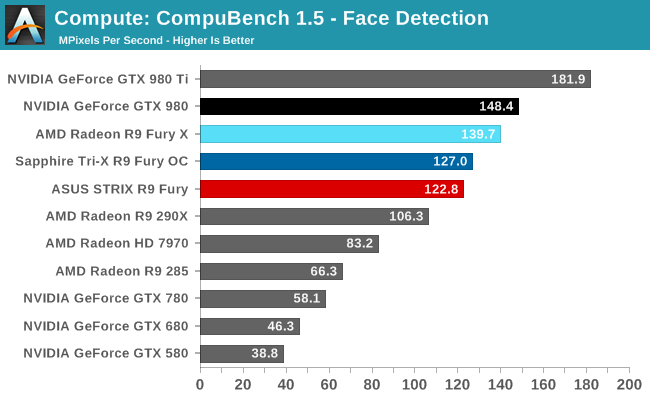
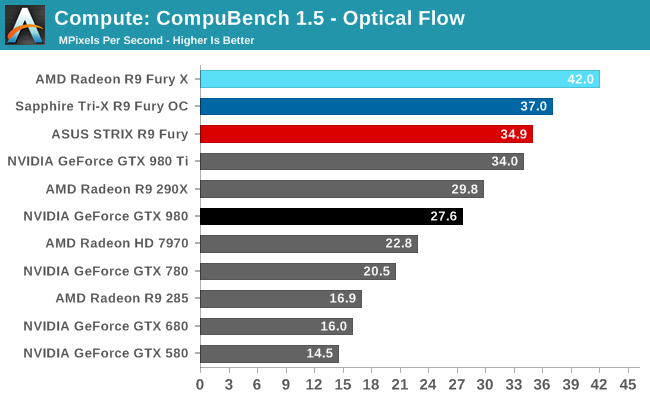

Not unlike LuxMark, tests where the R9 Fury X did well have the R9 Fury doing well too, particularly the optical flow sub-benchmark. The drop-off in that benchmark and face detection is about what we’d expect for losing 1/8th of Fiji’s CUs. On the other hand the particle simulation benchmark is hardly fazed beyond the clockspeed drop, indicating that the bottleneck lies elsewhere.
Our 3rd compute benchmark is Sony Vegas Pro 13, an OpenGL and OpenCL video editing and authoring package. Vegas can use GPUs in a few different ways, the primary uses being to accelerate the video effects and compositing process itself, and in the video encoding step. With video encoding being increasingly offloaded to dedicated DSPs these days we’re focusing on the editing and compositing process, rendering to a low CPU overhead format (XDCAM EX). This specific test comes from Sony, and measures how long it takes to render a video.
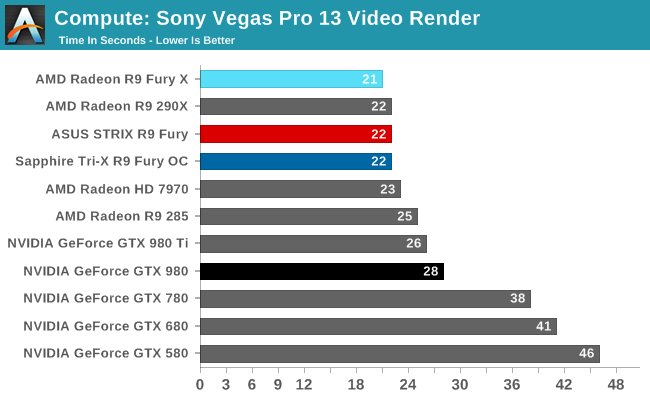
At this point Vegas is becoming increasingly CPU-bound and will be due for replacement. The R9 Fury comes in one second behind the chart-topping R9 Fury X, at 22 seconds.
Moving on, our 4th compute benchmark is FAHBench, the official Folding @ Home benchmark. Folding @ Home is the popular Stanford-backed research and distributed computing initiative that has work distributed to millions of volunteer computers over the internet, each of which is responsible for a tiny slice of a protein folding simulation. FAHBench can test both single precision and double precision floating point performance, with single precision being the most useful metric for most consumer cards due to their low double precision performance. Each precision has two modes, explicit and implicit, the difference being whether water atoms are included in the simulation, which adds quite a bit of work and overhead. This is another OpenCL test, utilizing the OpenCL path for FAHCore 17.
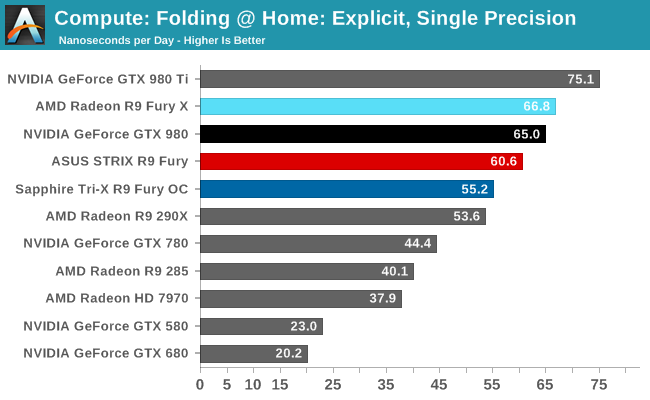
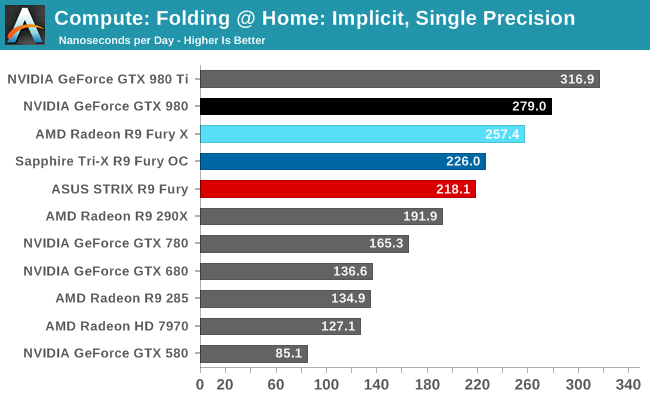

Overall while the R9 Fury doesn’t have to aim quite as high given its weaker GTX 980 competition, FAHBench still stresses the Radeon cards. Under single precision tests the GTX 980 pulls ahead, only surpassed under double precision thanks to NVIDIA’s weaker FP64 performance.
Wrapping things up, our final compute benchmark is an in-house project developed by our very own Dr. Ian Cutress. SystemCompute is our first C++ AMP benchmark, utilizing Microsoft’s simple C++ extensions to allow the easy use of GPU computing in C++ programs. SystemCompute in turn is a collection of benchmarks for several different fundamental compute algorithms, with the final score represented in points. DirectCompute is the compute backend for C++ AMP on Windows, so this forms our other DirectCompute test.
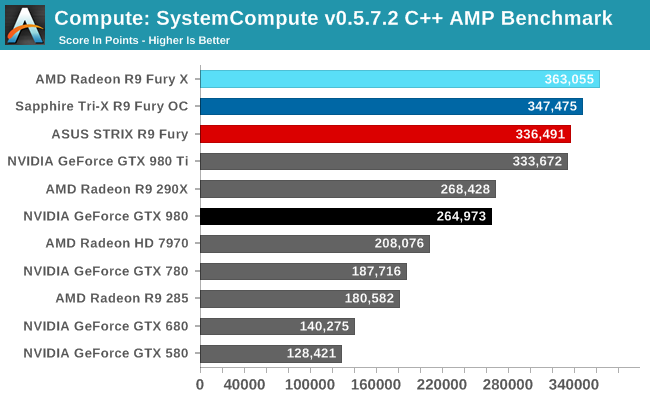
As with our other tests the R9 Fury loses some performance on our C++ AMP benchmark relative to the R9 Fury X, but only around 8%. As a result it’s competitive with the GTX 980 Ti here, blowing well past the GTX 980.










288 Comments
View All Comments
refin3d - Friday, July 10, 2015 - link
This is exactly what I was thinking... A few months ago when the 980 was launched I recall the 290X not being able to compete with it, and now they are trading blows. Shows some good work by the driver's team.Maybe AMD's cards are like a fine wine; you have to give them time to age before they reach their maximum potential haha.
jann5s - Friday, July 10, 2015 - link
Making driver improvements is nice, and shows commitment from AMD, but it could also mean the original state of the drivers was not so good, and there was indeed a lot to improve. I hope this is not the case, but I'm not sure.Asomething - Friday, July 10, 2015 - link
Amd drivers weren't as good, its one of the reasons they switched to GCN in the 1st place, their drivers got a lot better since those days apparently.FlushedBubblyJock - Wednesday, July 15, 2015 - link
Apparently not, as most games don't run even for the reviewers on GCN "release day".The endless fantasies in amd fanboy minds though, those run, run their course, are debunked, go into schizoid mode and necromance themselves, then of course we are treated to the lying again.
FlushedBubblyJock - Wednesday, July 15, 2015 - link
SO FOR 2 FULL YEARS AMD 290 290X 290 UBER OWNERS GOT SCREWED " by the drivers that are just as good as Nvidia's as that problem amd had was 4 years ago or more" !!???I get it amd fanboy ... it's all you have left after the constant amd failures and whippings they've taken from nVidia - the fantasy about "amd drivers" TWO AND A HALF YEARS AFTER RELEASE.
Oxford Guy - Saturday, July 11, 2015 - link
A conspiracy theory is that Nvidia has purposefully hampered performance for Kepler.Cellar Door - Monday, July 13, 2015 - link
Look at 780Ti - at launch 290X could not touch it. Where is the 780Ti now?!?!? - what a crappy investment was that for anyone that got one.
CiccioB - Monday, July 13, 2015 - link
You may be over excited to have noted that in the review there's a GTX780, not a 780Ti. Seen the difference between the cards, if some improvements have been created, they are quite marginal.It's really funny to see these sort of myth raise from time to time without a real study on the thing. All impressions, not a single number reported as a proof of anything.
Yet, continue to believe in what you want. Unfortunately for you the market doesn't really care.
Cellar Door - Monday, July 13, 2015 - link
You should check out the techpowerup review - they have a 780TI in it. Then you will understand what you here are calling a myth. 780TI is positioned just before a 290X, hahah, pretty sad to be honest.CiccioB - Monday, July 13, 2015 - link
You can look at Anandtech reviews. The only game that was in benchmark suite as today is Crisis 3.Look what are the changes between the 290X and the 780 (not Ti).
Here the two boards when on par at 290X presentation, and they still are on par today.
You can see the difference are the same and we are speaking for 1FPS change for both GPUs. Yes, miraculous drivers. Come on, return on Earth with your fantasies.